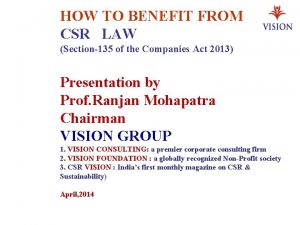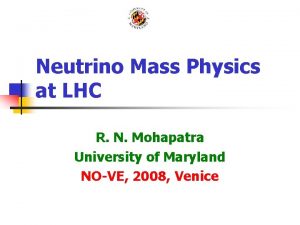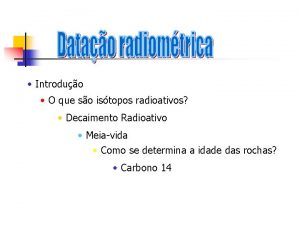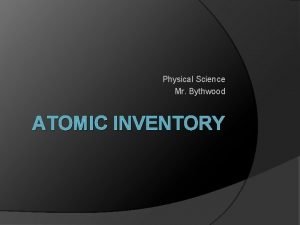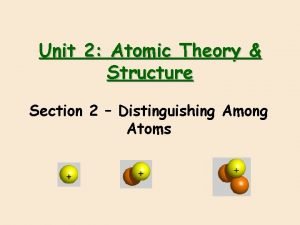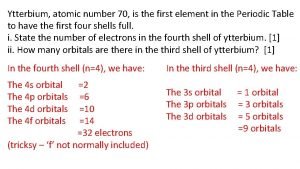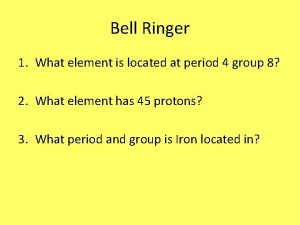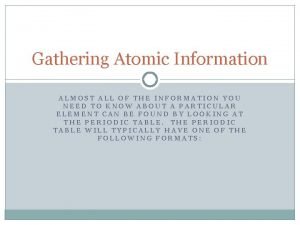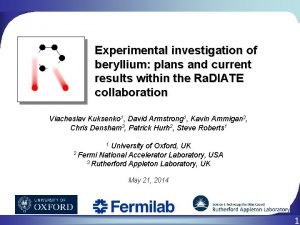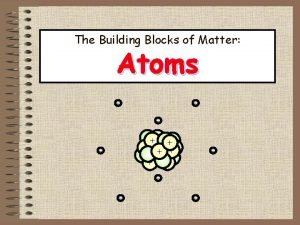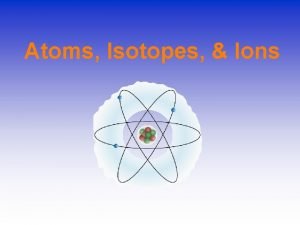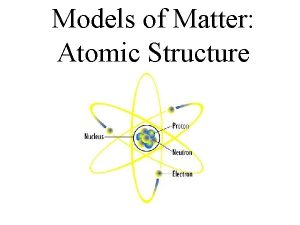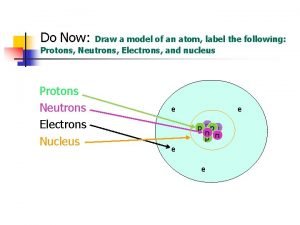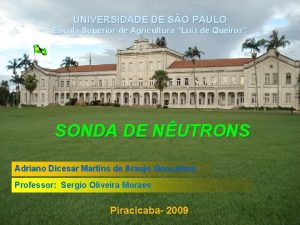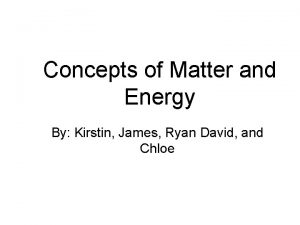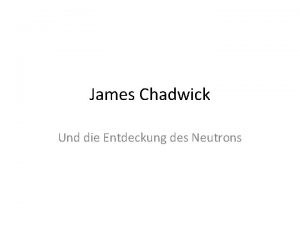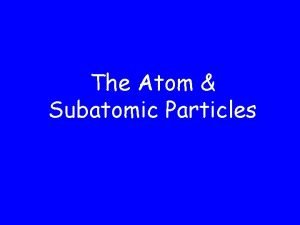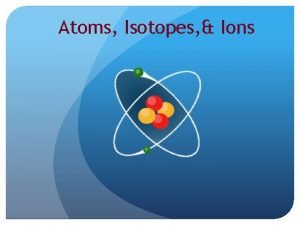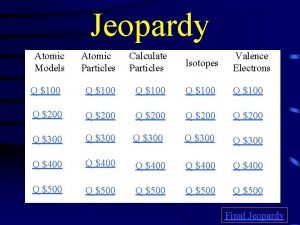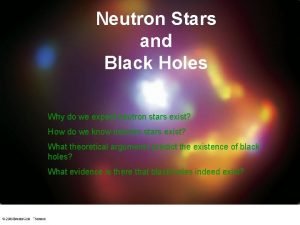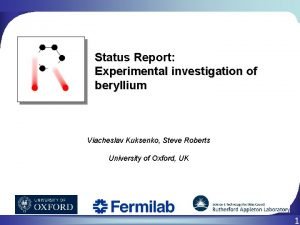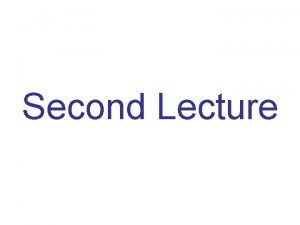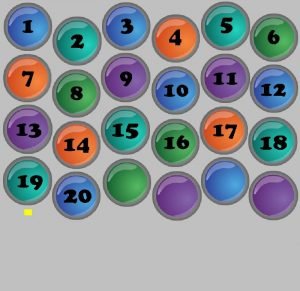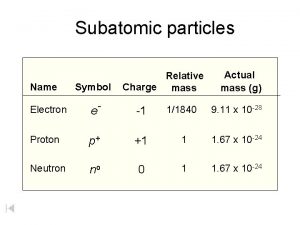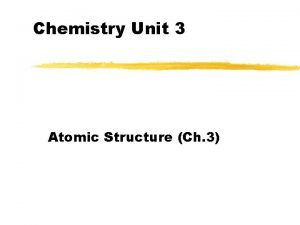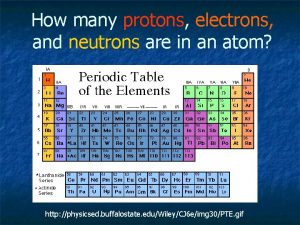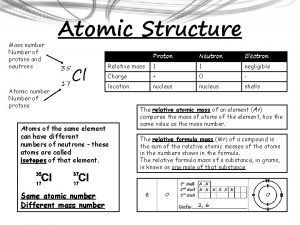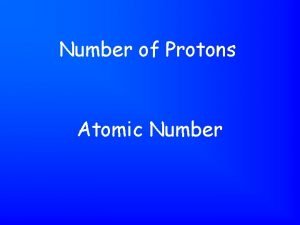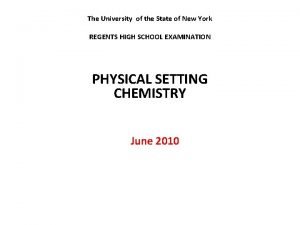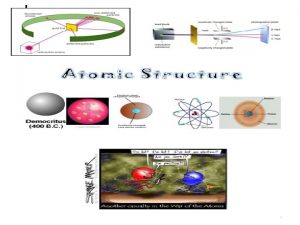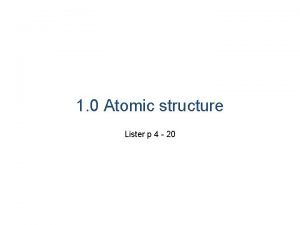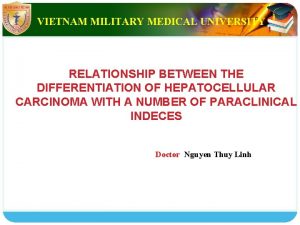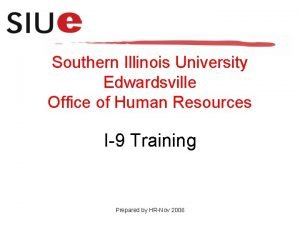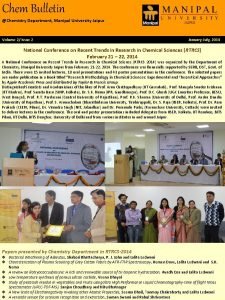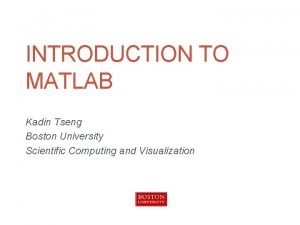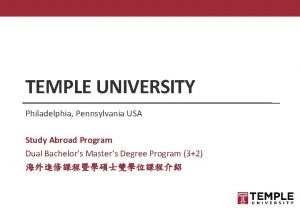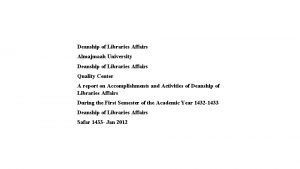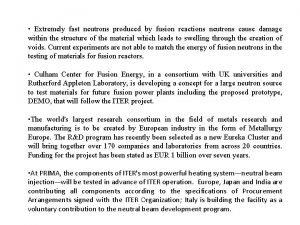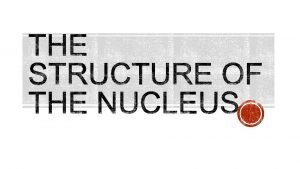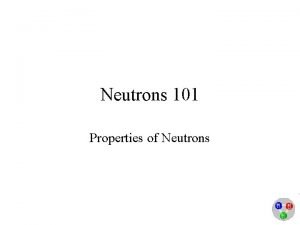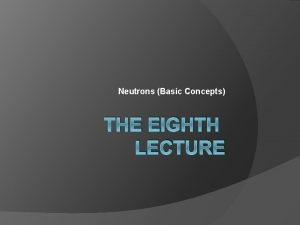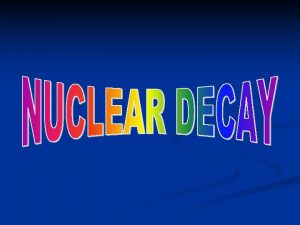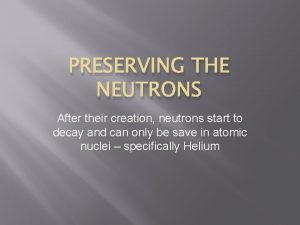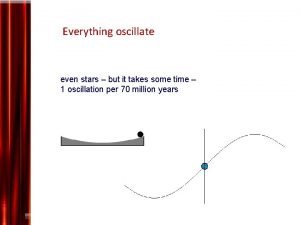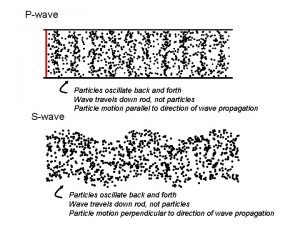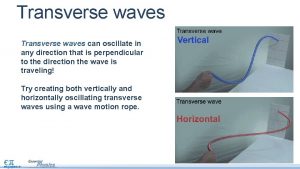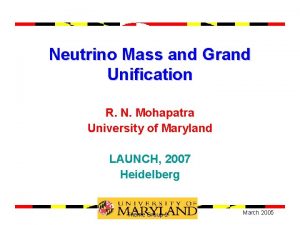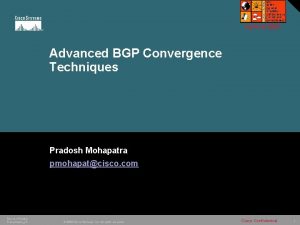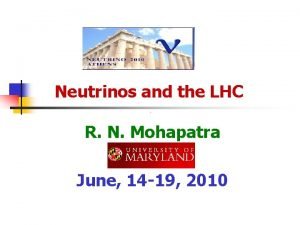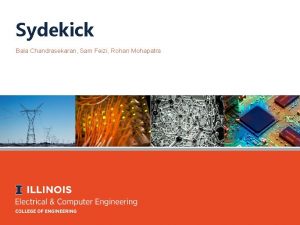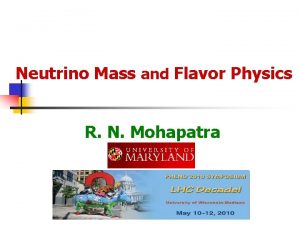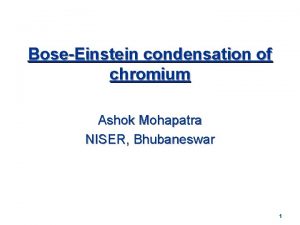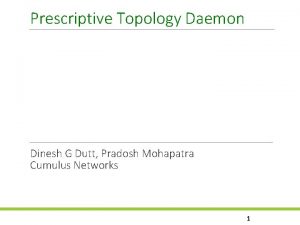Do Neutrons Oscillate R N Mohapatra University of




























































- Slides: 60

Do Neutrons Oscillate ? R. N. Mohapatra University of Maryland Beijing Colloqium, June, 2007 Theme Group 2 March 2005

Particle oscillations • Oscillations of quantum mechanical states is a familiar phenomenon in Nature. • In the domain of particle physics, electrically neutral particles such as Kaons and neutrinos have been observed to oscillate, teaching us a great deal about the fundamental forces and matter. • Neutron is another neutral particle- could it possibly be having any oscillation ? Theme Group 2 March 2005

What can neutrons Oscillate to ? • Conservation of electric charge allows: (i) Neutron to anti-neutron (requires violation of baryon number) (ii) Neutron to mirror neutron; (requires the existence of a mirror universe. ) Both involve untested ideas and will reveal new physics. Here I discuss case (i) since there are reasons to suspect baryon number violation. Theme Group 2 March 2005

Why Baryon number non-conservation ? • Standard model has it. • Understanding the origin of matter in the universe requires it. • Most interesting new physics scenarios beyond the SM predict it. Theme Group 2 March 2005

Modes of interest Two modes of interest are: (i)Proton decay (ii)Neutron-anti-neutron oscillation Theme Group 2 March 2005

Phenomenology of N-N-bar Osc Theme Group 2 March 2005

Present expt situation in N-N-bar Osc. Range accessible to current reactor fluxes: Present limit: ILL experiment: Baldoceolin et al. (1994) New proposal by Y. Kamyshkov, M. Snow et al for an expt. DUSEL GOAL: Figure of merit ~ Theme Group 2 March 2005

De-gaussing of Earth B necessary • In free N-N-bar osc. , in the presence of Earth Mag. Field • Effect will be suppressed. • Needed de-gaussing to the level of Nano. Tesla. • Mu-metal shielding can do it. Known technology. Theme Group 2 March 2005

Oscillation inside Nuclei Theme Group 2 March 2005

Searches in Nucleon decay • Inside a nucleus e. g. Oxygen, • giving For This leads to nucleon lifetime Limits from Super-K, Soudan, IMB, SNO are of this order. Theme Group 2 March 2005

Comparision P-decay vs N-N-bar Theme Group 2 March 2005

Free vs Bound N-N-bar • Nuclear Physics uncertain: Uncertainty in R -need to do free neutron osc. Search. Theme Group 2 March 2005

A Proposal for N-Nbar search experiment at DUSEL Dedicated small-power TRIGA research reactor with cold neutron moderator vn ~ 1000 m/s Vertical shaft ~1000 m deep with diameter ~ 6 m at DUSEL Large vacuum tube, focusing reflector, Earth magnetic field compensation system Detector (similar to ILL N-Nbar detector) at the bottom of the shaft (no new technologies) Kamyshkov, Snow et al. Theme Group 2 March 2005

Present collaboration: • Seeking collaborators: new site for expt. Theme Group 2 March 2005

Physics reason for N-N-bar • Different baryon nonconserving processes probe different physics: • Need both proton decay and N-N-bar for complete understanding of physics beyond SM Theme Group 2 March 2005

Modes and new physics scales • P->e+ , P->K mediated by the operator: Obeys Present lower limit on Implies This probes very high scales close to GUT scale. Theme Group 2 March 2005

B-L=2 Processes • Neutron-anti-neutron oscillations : PROBES INTERMEDIATE SCALES; Leads to Or for M= Theme Group 2 March 2005

Power counting: model dependent • Depends on : (i) low energy symmetry (ii) Te. V scale particle spectrum: • Te. V scale SUSY: sparticles < Te. V scale • Dominant P-decay operator Severely constrains SUSY GUTs : N-N-bar operator Allows N-N-bar to probe scales upto Ge. V. Much weaker suppressions also possible allowing probes till 10^11 -10^12 Ge. V. Theme Group 2 March 2005

Key symmetry is B-L • Proton decay does not search for B-L breaking whereas Neutron antineutron oscillation does. • B-L connected to neutrino mass-N-N-bar can clarify the origin of nu mass. Theme Group 2 March 2005

Plan for the rest of the talk 1. Why B-L symmetry ? 2. Two classes of local B-L models 3. Proton Decay, and N-N-bar Oscillations as tests of these models. Theme Group 2 March 2005

Why B-L Symmetry ? • Standard model has global B-L symmetry. • Immediate questions therefore are: • What is the nature of this symmetry ? Is it a global or local symmetry ? • Is it broken or exact ? If broken, what is the breaking scale and what new physics is associated with it ? Theme Group 2 March 2005

Any Hint of B-L symmetry beyond SM? • Neutrino Mass points towards a BL symmetry beyond the standard model. • As does SUSY dark matter. • One popular way to understand the origin of matter also involves B-L breaking. Theme Group 2 March 2005

Neutrino mass and • -standard model Starting point: add RH neutrino to SM for nu mass: Theme Group 2 March 2005

Seesaw paradigm for neutrino masses Add right handed neutrinos to the standard model and give them a large Majorana mass: Minko wski (77); Gell-Mann, Ramond, Slansky; Yanagida; Glashow; RNM, Senjanovic (79) Theme Group 2 March 2005

Seesaw scale and B-L symmetry • Seesaw formula applied to atmospheric neutrino data tells us that • Simple way to understand this inequality is to have a new symmetry that protects M_R. B-L is the appropriate symmetry since Majorana mass of RH neutrino breaks B-L by 2 units. Theme Group 2 March 2005

Another reason to suspect a B-L sym. • Common belief: SUSY at Te. V scale for various reasons: (i) Gauge hierarchy (ii) EWSB: origin of W, Z mass (iii) Dark matter: requires R-parity exact. Note that if B-L is a good symmetry beyond MSSM and breaks by two units (as in the RH neutrino mass), R-parity is exact in MSSM, dark matter is stable: otherwise not !! (RNM, 86; Font, Ibanez, Quevedo, 89; Martin, 92) Theme Group 2 March 2005

Origin of matter and B-L • If matter-anti-matter symmetry originated from early universe above the Te. V scale, then, it must break B-L. If it did not, Sphalerons would erase it !! • Proof: Suppose such that it has generated in the early Universe is B- L=0; Then = ; But B+L is violated by sphalerons which are in equilibrium down to the electroweak phase transition temp and will therefore wipe out B+L and hence all baryon asymmetry. Theme Group 2 March 2005

B-L: Local or Global ? • SM or MSSM: • But • So B-L is not a local symmetry. • Add the RH neutrino: • (B-L) becomes a gauge-able symmetry. • We will consider B-L to be a local symmetry. Theme Group 2 March 2005

New electroweak symmetry with B-L • Gauge group: • Fermion assignment • Higgs fields: Theme Group 2 March 2005

Symmetry breaking Theme Group 2 March 2005

Electric Charge Formula • New Improved Formula for electric charge Standard model: Y has no physical meaning. The formula In LR models: Theme Group 2 March 2005

Parity Violation leads to B-L violation • Electric charge formula of LR models imply: • Connects the origin of parity violation to B-L violation. Understanding B-L violation will elucidate the origin of parity violation. implies: or Majorana neutrinos or neutron-anti-N oscill. (RNM, Marshak, 80) Theme Group 2 March 2005

Minimal Models with B-L and N-N-bar • Need to unify quarks and leptons to transmit the BL=2 information to generate N-N-bar oscillations. • Two simple models with local B-L: (A): SO(10) : the minimal GUT theory with B-L (Georgi; Fritzsch and Minkowski (75)) (B) Partial Unif. Th. In both cases, fermions fit into the basic representation: • (Pati, Salam, 73) Theme Group 2 March 2005

B-L scale in SO(10) Grand unification Note that SUSY at TEV SCALE + no new physics till Ge. V implies that coupling constants unify: This suggests that perhaps local B-L is part of a grand unifying symmetry and it breaks at GUT scale. Related physics is GUT physics. Theme Group 2 March 2005

Does seesaw favor GUT scale B-L breaking ? • Atmospheric mass measured by Super-K can be related to B-L scale using the seesaw formula: assuming GUT relation for the 3 rd generation that This gives for the seesaw scale IN THIS CASE, SEESAW SCALE IS GUT SCALE and B-L PHYSICS IS GUT PHYSICS: Theme Group 2 March 2005

LOWER B-L SCALE POSSIBLE ? However, Experiments do not tell us the value of. if is suppressed by some symmetries (e. g. family sym. ), seesaw scale could be lower. In case of lower B-L scale, possible unification theory is the Model. Minimal B-L scale in this case is: Could also be at the Te. V scale. Theme Group 2 March 2005

So two key questions are: • What is the physics associated with B-L symmetry in this case ? • What is the scale of B-L symmetry ? Theme Group 2 March 2005

Message of this talk: P-decay, N-N-bar osc. probe the scale of local B-L sym. P-decay if it is GUT scale and N-N-bar if it is intermediate!! HOW SO ? Theme Group 2 March 2005

Digression on GUTs and Proton decay SU(5) as a Warm-up example: Theme Group 2 March 2005

Nucleon Decay in Generic SUSY GUTs • Gauge Boson exchange: Theme Group 2 March 2005

SUSY changes GUT scale dependence • Sakai, Yanagida, Weinberg (1982) • Murayama, Pierce; Bajc, Perez, Senjanovic (02); Perez, Dorsner, Rodrigo(06) Theme Group 2 March 2005

Predictions for proton decay in SO(10)-16 • B-L could be broken either by {16}-H or {126}H. • SU(5) type problem avoided due to cancellation between diagrams. • Proton decay in {16} models: highly model dependent: in one class of models (Babu, Pati and Wilczek (2000)) Theme Group 2 March 2005

Predictions for proton decay in SO(10)-126 • Minimal SO(10) model with 10+126 which predict neutrino mixings: • 4 parameter model: predicts • (Goh, R. N. M, Nasri, Ng (2004)) Decay model highly suppressed. So again proton decay modes like these are highly model dependent. Theme Group 2 March 2005

Truly “model independent” prediction • Gauge exchange mode P-> e+ , which is predicted in minimal GUT models to be around 10^36 years. • “The true holy grail of grand unification” • N-N-BAR IN SO(10) HIGHLY SUPPRESSED. Theme Group 2 March 2005

Now to N-N-BAR OSCILLATION • Can observable N-N-bar emerge in realistic seesaw models with sub-GUT B-L scale ? • Second question is: since high dim N-N-bar operators go out of equilibrium only around the electroweak scale, are they not going to erase any preexisting baryon asymmetry • So can one understand the origin of matter if N-N-bar is visible in expts. ? • The answers to both questions -“YES”. Theme Group 2 March 2005

Testing Sub-GUT B-L with N-N-bar • Recall with SM spectrum in the Te. V range, NN operator is • O • Feynman diagram for N-N-bar Feynman no. SUSY • RNM and Marshak, 80 • Tiny n-n-bar for M L scales ? >100 Te. V. Can Theme Group 2 n-n-bar test higher BMarch 2005

Things change with SUSY and new particles A. Dominant operator with SUSY: B. SUSY + diquark Higgs field Note weaker Seesaw suppression , at Te. V scale Supression Still weaker ! C. If the Te. V scale has fields, effective op. is /M Theme Group 2 Weakest Suppression March 2005

A G(224) theory for case B and N-N-bar Theme Group 2 March 2005

Estimate of N-N-bar in Minimal 224 model: • New Feynman diagram for N-N-bar osc. Observable N-N-bar osc (Dutta, Mimura, RNM; PRL (2006) Theme Group 2 March 2005

Other examples-Babu, RNM, Nasri-PRL (2007) • 3 x 2 seesaw model with the third RH neutrino in the Te. V scale and decoupled from the neutrino sector: • Plus a pair of color triplets: X and X-bar with couplings: + Impose R-parity symmetry as in MSSM. This simple extension provides a remarkably natural model for dark matter, neutrinos and baryogenesis and has testable predictions !! Theme Group 2 March 2005

N-N-bar Prediction • N-N-bar oscillation: Diagram involves Majorana N exchange • Effective strength: • Will lead to N-N-bar osc via the s-content in neutron. • Transition time expected to be around 10^8 sec. Theme Group 2 March 2005

Baryogenesis in N-N-bar models • Usual argument : Any early universe baryon asymmetry will be erased by fast N-N-bar transitions being in equilibrium: Typical out of Equilibrium T is around 100 Ge. V. Need a mechanism for baryogenesis below the electroweak breaking scale. Recent work which resolves this issue by post-sphaleron baryogenesis: Babu, RNM, Nasri PRL, (2006, 2007) Theme Group 2 March 2005

Baryogenesis Diagrams in the second model Possible to obtain right n_B/N_gamma Theme Group 2 March 2005

Proton decay vs N-N-bar oscillation Theme Group 2 March 2005

Conclusion • With the discovery of neutrino mass the case for N-N-bar oscillation is a lot stronger now than it was in the 1980 s. Urge new search at the level of 10^10 sec to test for B-L seesaw scale around 10^11 Ge. V as against GUT scale seesaw. • N-N-bar discovery will completely change thinking on grand unification. • As far as Proton decay goes, predictions below 10^36 yrs are model dependent; while they should be done, the true value of Pdecay as a test of GUT idea is the 10^36 yrs level search and should be the ultimate goal. Theme Group 2 Thank you for your attention. March 2005

Role of Lepton Flavor Violation • Standard model with Majorana neutrino mass without supersymmetry and high scale seesaw: Very tiny: With SUSY, things are different. Theme Group 2 March 2005

SUSY seesaw and FCNC effects • Neutrino mixings induce slepton mixings at low scale via radiative corrections and hence FCNC effects. • Slepton mixings are proportional to Yukawa mixings that go into the seesaw formula: • Since neutrino masses are known, if M_R= fv_R (the B-L breaking scale) is lower , Y_nu will be smaller and hence will be the slepton mixing effects. Theme Group 2 March 2005

Generic predictions for Theme Group 2 March 2005

Lower V_BL • Branching ratio lower by v_BL square. So non-observation of any effect at MEG expt along with a positive signal for N-N-bar oscillation will indicate lower B-L scales. Only exception is if B-L scale is the Te. V range: In this case even without SUSY, mu-> e +gamma Br. Can be observable. Theme Group 2 March 2005

Conclusion • With the discovery of neutrino mass the case for N-N-bar oscillation is a lot stronger now than it was in the 1980 s. Urge new search at the level of 10^10 sec to test for B-L seesaw scale around 10^11 Ge. V as against GUT scale seesaw. • N-N-bar discovery will completely change thinking on grand unification. • As far as Proton decay goes, predictions below 10^36 yrs are model dependent; while they should be done, the true value of Pdecay as a test of GUT idea is the 10^36 yrs level search and should be the ultimate goal. Theme Group 2 Thank you for your attention. March 2005
 Ranjan mohapatra csr vision
Ranjan mohapatra csr vision Abhishek mohapatra
Abhishek mohapatra Oscillate in a sentence
Oscillate in a sentence Oscillate
Oscillate Oscillate
Oscillate Qumica
Qumica Atomic inventory
Atomic inventory How many neutrons in sulfur 33
How many neutrons in sulfur 33 Ytterbium number of protons
Ytterbium number of protons Chromium 58 neutrons
Chromium 58 neutrons Lithium protons neutrons electrons
Lithium protons neutrons electrons How many neutrons does the isotope n-14 have
How many neutrons does the isotope n-14 have Colbot-60 has how many neutrons?
Colbot-60 has how many neutrons? Protons and neutrons size
Protons and neutrons size 39k+ protons neutrons electrons
39k+ protons neutrons electrons Sulfur number of neutrons protons and electrons
Sulfur number of neutrons protons and electrons Carbon
Carbon Can an atom have more neutrons than protons
Can an atom have more neutrons than protons Number of neutrons helium
Number of neutrons helium Nonmetal halogen family 35 amu
Nonmetal halogen family 35 amu Sonda de neutrons
Sonda de neutrons Can an atom have more neutrons than protons
Can an atom have more neutrons than protons Entdeckung des neutrons
Entdeckung des neutrons I am the first element in the fourth period
I am the first element in the fourth period U 238 protons neutrons electrons
U 238 protons neutrons electrons 39k+ protons neutrons electrons
39k+ protons neutrons electrons Atomic structure jeopardy
Atomic structure jeopardy Find the number of protons h
Find the number of protons h Atoms with 4 valence electrons
Atoms with 4 valence electrons Neutron star
Neutron star Colbot-60 has how many neutrons?
Colbot-60 has how many neutrons? Atom subatomic particles
Atom subatomic particles Lithium number of protons and neutrons
Lithium number of protons and neutrons Neutrons
Neutrons An industrially important element contains 26
An industrially important element contains 26 Describe neutrons.location: charge: mass:
Describe neutrons.location: charge: mass: Neutrons in hydrogen
Neutrons in hydrogen Number of neutrons xenon
Number of neutrons xenon Neutrons
Neutrons 12c6 number of protons and neutrons
12c6 number of protons and neutrons Can an atom have more neutrons than protons
Can an atom have more neutrons than protons Democritus timeline
Democritus timeline Lithium mass number
Lithium mass number 沈榮麟
沈榮麟 Vietnam military medical university
Vietnam military medical university Southern illinois university human resources
Southern illinois university human resources Manipal university chemistry department
Manipal university chemistry department Bu matlab
Bu matlab Augusta university human resources
Augusta university human resources Syracuse veterans career transition program
Syracuse veterans career transition program University of science and technology kumasi
University of science and technology kumasi Covenant university core values
Covenant university core values University physics
University physics Dubna state university
Dubna state university Study abroad application temple
Study abroad application temple Wendy robinson exeter
Wendy robinson exeter Holy sophia university
Holy sophia university Rush university
Rush university Brown university computer science faculty
Brown university computer science faculty Ian jones bournemouth university
Ian jones bournemouth university Almajmaah university
Almajmaah university
